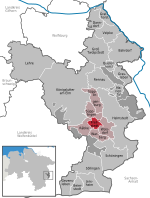The Schöningen spears are a set of ten wooden weapons from the Palaeolithic Age that were excavated between 1994 and 1999 from the 'Spear Horizon' in the open-cast lignite mine in Schöningen, Helmstedt district, Germany. The spears are the oldest hunting weapons discovered and were found together with animal bones and stone and bone tools. Being used by the oldest known group of hunters, they provided never before uncovered proof that early human ancestors were much closer to modern humans in both complex social structure and technical ability than thought before. The excavations took place under the management of Hartmut Thieme of the Lower Saxony State Service for Cultural Heritage (NLD).
The age of the spears, originally assessed as being between 380,000 and 400,000 years old, was estimated from their stratigraphic position, 'sandwiched between deposits of the Elsterian and Saalian glaciations, and situated within a well-studied sedimentary sequence.' However, more recently, thermoluminescence dating of heated flints in a deposit beneath that which contained the spears date the spears to between 337,000 and 300,000 years old, placing them at the end of the interglacial Marine Isotope Stage 9. All studies place the spears in the Holstein interglacial, which is commonly correlated to either of the mentioned marine isotope stages, MIS 11 (424–374 thousand years ago) and MIS 9 (337–300 thousand years ago).
The Schöningen spears thus may predate the fragmented Clacton spear point and in so represent the oldest known worked wooden implements, but surely the oldest complete wooden weapons.
To date, hominin remains have not been discovered from the Schöningen Pleistocene deposits, and therefore the species that crafted and used the wooden weapons and other tools at Schöningen remains uncertain. The most likely candidates are Homo heidelbergensis
or early Neanderthals. The spears provide clear evidence of the importance of wood as a material for Palaeolithic tools, and also further support the practice of hunting by Middle Pleistocene humans.
The spears are associated with animal bones, over 90% of which represent the extinct horse species Equus mosbachensis.
 Continue reading on Wikipedia
Continue reading on Wikipedia 







